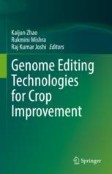Search
Search Results
-
Prospects of resistance of some Sudanese tomato accessions to South American tomato pinworm, Tuta absoluta (Meyrick) (Lepidoptera: Gelechiidae) and its mechanism
A randomized complete block design field experiment was conducted for three consecutive seasons at the Kassala and Gash Research Station experimental...

-
Identification and characterization of RNA polymerase II (RNAP) C-Terminal domain phosphatase-like 3 (SlCPL3) in tomato under biotic stress
BackgroundBacterial diseases are a huge threat to the production of tomatoes. During infection intervals, pathogens affect biochemical, oxidant and...

-
Salt tolerance of endophytic root bacteria and their effects on seed germination and viability on tomato plants
Salinity is one of the most brutal environmental factors limiting the productivity of agricultural lands worldwide. It is considered that the...

-
Biological and molecular characterization of Tomato spotted wilt orthotospovirus isolates from pepper cultivars with the resistance gene Tsw from Turkey
Tomato spotted wilt orthotospovirus (TSWV) is one of the most widespread and damaging pepper viruses worldwide. Until recently, disease control has...

-
Assessment of tomato genotypes against the whitefly, Bemisia tabaci Gennadius (Hemiptera: Aleyrodidae) and Tomato leaf curl virus under controlled condition
The tomato leaf curl viruses (ToLCVs) causing tomato leaf curl disease (ToLCD) in tomatoes is one of the significant constraints for tomato...

-
Genome Editing for Tomato Improvement
Tomato is one of the most important horticultural crops worldwide because of its nutritional value and derived industrial products. During the...
-
Major quantitative trait locus qLA3.1 is related to tomato leaf angle by regulating cell length at the petiole base
Key messageqLA3.1, controlling leaf angle in tomato, was fine-mapped to an interval of 4.45 kb on chromosome A03, and one gene encoding auxin...

-
Genes involved in auxin biosynthesis, transport and signalling underlie the extreme adventitious root phenotype of the tomato aer mutant
The use of tomato rootstocks has helped to alleviate the soaring abiotic stresses provoked by the adverse effects of climate change. Lateral and...

-
Identification of a new type of resistance breaking strain of tomato spotted wilt virus on tomato bearing the Sw-5b resistance gene
Sw-5b is a widely used resistance gene in tomato breeding to control tomato spotted wilt virus (TSWV). The NSm protein encoded by TSWV is identified...

-
Molecular characterization and pathogenicity of an infectious clone of tomato leaf curl New Delhi virus isolate infecting Cucumis melo
Tomato leaf curl New Delhi virus (ToLCNDV) is a member of the genus Begomovirus , and causes devastating disease in the world. In recent years,...

-
Host response of five potato cultivars to Meloidogyne nematodes
Potato ( Solanum tuberosum L.) is a well-known food crop that is regarded as an important component in the worldwide battle against hunger and...

-
Utilizing genetic diversity to select tomato lines tolerant of tomato yellow leaf curl virus based on genotypic coefficient of variation, heritability, genotypic correlation, and multivariate analyses
Tomato yellow leaf curl virus (TYLCV) is one of the most destructive pathogens for tomato crops. The development of TYLCV-tolerant tomato lines (TLs)...

-
Transcriptional responses to Fusarium oxysporum f. sp. lycopersici (Sacc.) Snyder & Hansen infection in three Colombian tomato cultivars
BackgroundFusarium oxysporum f. sp. lycopersici ( Fol) is a compendium of pathogenic and non-pathogenic fungal strains. Pathogenic strains may cause...

-
Tomato Chemical Defenses Intensify Corn Earworm (Helicoverpa zea) Mortality from Opportunistic Bacterial Pathogens
Insect herbivores face multiple challenges to their ability to grow and reproduce. Plants can produce a series of defenses that disrupt and damage...

-
Tomato potato onion intercrop** induces tomato resistance against soil borne pathogen, Fusarium oxysporum through improvement soil enzymatic status, and the metabolic status of tomato root and shoot
Intercrop** is a tried-and-true approach for restoring depleted agricultural soils, making better use of resources, controlling pests and disease,...

-
Population analysis reveals the roles of DNA methylation in tomato domestication and metabolic diversity
DNA methylation is an important epigenetic marker, yet its diversity and consequences in tomato breeding at the population level are largely unknown....
-
Cellular Energy Allocation of Tuta absoluta (Lepidoptera: Gelechiidae) treated with Flubendiamide and Thiocyclam Hydrogen Oxalate on Different Tomato Cultivars
The tomato leaf miner, Tuta absoluta (Meyrick), is the most important pest for tomato production in Iran. The effect of flubendiamide and thiocyclam...

-
Effects of grafting with wild tomato (Solanum pimpinellifolium and Solanum habrochaites) rootstocks on growth and leaf mineral accumulation in salt stress
The positive response of grafting by tolerant rootstocks or scion-stock interactions on yield and fruit traits of tomatoes under saline conditions is...

-
Physiological and histopathological assessments of the susceptibility of different tomato (Solanum lycopersicum) cultivars to early blight disease
The current research aims to evaluate the susceptibility of the tomato of the tomato ( Solanum lycopersicum ) cultivars 65,015 (CV1), Basma (CV2),...

-
Characterization of yield and fruit quality parameters of Vietnamese elite tomato lines generated through phenotypic selection and conventional breeding methods
Tomato ( Solanum lycopersicum L.) is the second most important vegetable crop after potatoes, and global demands have been steadily increasing in...

